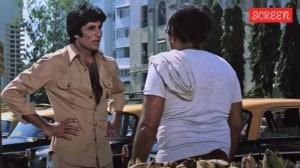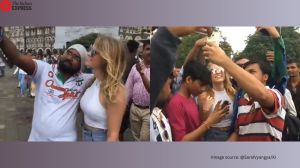Military Digest: Mahavir Chakra for a civilian, Flying Hanuman marching tune – vignettes from India’s first year as a republic
Among the first Maha Vir Chakras awarded for bravery after the country became a republic was to a civilian attached to a field unit of Madras Sappers.
 Ram Chandar of 14 Field Company of Madras Sappers was awarded the Maha Vir Chakra, the second highest honour for gallantry, for his coolness and courage under hostile fire. (Express Photo)
Ram Chandar of 14 Field Company of Madras Sappers was awarded the Maha Vir Chakra, the second highest honour for gallantry, for his coolness and courage under hostile fire. (Express Photo)On January 26, 1950, India became a republic and transitioned from being a dominion of the British Empire to a sovereign nation. The first year of the new republic saw many changes and prominent among them were those associated with the defence services, with new medals instituted and fresh marching tunes composed to replace the colonial ones.
Not many are aware that among the first Maha Vir Chakras awarded for bravery immediately after the country became a republic was to a civilian attached to an engineer field unit in Jammu and Kashmir. Dhobi (washerman) Ram Chandar of 14 Field Company of Madras Sappers was awarded the Maha Vir Chakra, the second highest honour for gallantry, for his coolness and courage under hostile fire.
Ram Chandar, son of Faqir Chand, was born in 1921 at Kot Kishan Chand in Punjab’s Jalandhar. He joined the Madras Engineering Group in May 1947.
On December 18, 1947, Chandar was accompanying a convoy to Jammu when it was attacked by a strong tribal force that had blocked a bridge by removing its decking (wooden flooring). Chandar helped his Officer Commanding Lt F D W Fallon to replace the decking while the bridge was under continuous fire. When the Officer Commanding was wounded, Chandar took his rifle and held the enemy at bay with well-directed covering fire that enabled the officer and his vehicle to cross the bridge. In the process, Chandar also inflicted five to six casualties on the enemy.
Cut off from the rest of the company, he helped the wounded officer — who was in a state of collapse due to blood loss — reach the nearest post located 8 miles away, ensuring that the way ahead was clear for the officer to move. The official citation making the award says: “Ram Chandar’s devotion to the officer was far beyond the call of duty. His coolness under fire and courage were unequalled”.
Flying Hanuman and other marching tunes
In the months following the first Republic Day, the Army headquarters instituted six cash prizes of Rs 150 each for composers of indigenous martial music for the army. In response, 400 composers from India and abroad sent in their entries which were carefully scrutinised and, where accompanied by notations, were tried out on instruments. Most of them were, however, found unsuitable as marching pieces for want of musical metre or the necessary length, which should be 120 to 150 bars.
However, the following six pieces were finally selected:
- “Flying Hanuman” by M S Pinto, Indian National Music Depot, Dhar State CI, Dhar
- “Kadam Barahae Ja” by Jemadar Sethe, Band Master, 5th RGR Centre, Dehradun
- “Vir Bharat” by Jemadar Sethe, Band Master, 5th RGR Centre, Dehradun
- “Desh ka Sipahi” by Jemadar Nathu Singh, National Defence Academy, Dehradun
- “Bharat March” by Edward Saldana, Radio Artist, Allahabad
- “Bapu ji Ka Naara” by Naik Bawa Singh, Depot Battalion, Bombay Engineer Centre, Corps of Engineers, Kirkee
- Uniform for the new ‘Brigade of The Guards’
One of the earliest initiatives of the first Indian Commander-in-Chief of the Army, General K M Cariappa, was to raise a new regiment with Indian recruitment in all classes in which no distinction was made for any particular caste or religion. This new regiment had been modelled after the various Guards Regiment of the British Army and had been named The Brigade of The Guards.
The Brigade was formed in 1949 from among volunteers of Indian Army units. In 1950, the new regiment, then the youngest in the Indian Army, got its uniform. The Army headquarters announced that it will henceforth be distinguished on all ceremonial occasions with red and gold hackles (short plume of feathers) as part of the headdress.
The new dress regulations give the officers a blue peak cap with a band in scarlet and gold check and peak with gold embroidery. Officers of the other Army units at the time wore ordinary peak caps. Badges of the Guards officers were to be scarlet embroidered with black edgings. Arm titles were to be in yellow silk with the words “THE GUARDS” embroidered on scarlet felt.
Junior Commissioned Officers and men were to continue to wear dark green berets for their headwear, the same as for normal infantry. Their dress would also remain the same olive green.
For formal occasions, officers wearing service dress were to be distinguished by a scarlet piping along the upper edge of the collar. With Service and Mess Dress, officers were to wear buttons which will be arranged differently for different battalions.
The headgear for evening wear was a side cap with gold piping along the edge of crown flaps and peak.
King’s Colours laid to rest
In November 1950, the King’s Colours of the various Indian Regiments, which had gone out of use in the Indian Armed Forces since January 26, 1950, when India became a republic, were laid at the Indian Military Academy Dehradun in a two-hour picturesque military ceremony.
For over a hundred years, until the late 19th century, the King’s Colours were carried in action by famous Indian Amy regiments, along with regimental colours, and they represented the King, for whom the units fought in battle. Many soldiers have sacrificed their lives to defend the honour of the colours and prevent them from falling into the hands of the enemy.
Modern warfare has however rendered the display of colours in action inexpedient, but they still occupy a pride of place on all ceremonial occasions. After active use, the reverential attitude adopted towards the Colours secures for them an appropriate resting place in a sacred edifice or a public building.
The then Defence Minister Baldev Singh and General Cariappa were present on the occasion along with other senior officers as the colonial past of the Indian Army was finally laid to rest.












